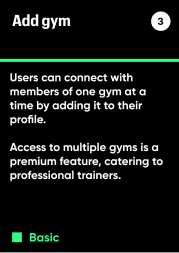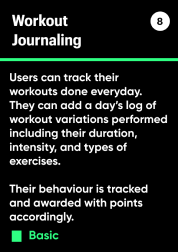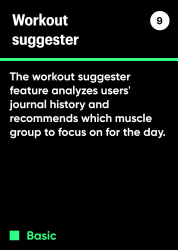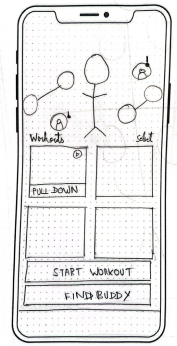top of page

Topics
Elevator
Strength Circles is an app to Swipe, Connect, and Share schedules to plan workouts with fellow gym members.
The App intends to make beginners feel included in the gym space, reducing gym intimidation and feelings of social alienation.
The product supports a freemium model with exclusive features for premium subscription and interstitial targeted ads to stay viable.
Role
Duration
Tools
Product designer
10 Weeks
Figma, Adobe Creative Suite
UX Research | User Interviews | Wireframing | UI Design | Visual Design | Usability Testing | Viability Testing
Scoping the problem.
One problem was evident from my 7 years of personal observation and experience at the gym. Almost all beginners face discomfort for the first few days at the gym being around an unknown crowd.
I identified 12 participants through a survey and conducted hour-long semi-structured scripted interviews to gather empathetic insights.
I debriefed the interview conversations and drafted a problem tree analysis to uncover actionable insights for solving the issue.
I created a persona of the ideal user and mapped their journey.

Meet Ben
A 19-yo who is out of shape and lacks fitness knowledge and experience.
I used to do curls for an hour"
- Dhruv, Research participant

Lost
Everyone's slams weights like that thing was all new to me”
- Dhruv, Research participant
Anxious
I just felt like uncomfortable and anxious because I just really wanted to find something to do."
- Urja, Research participant
Insecure
It feels like they know everything and you don't”
- Urja, Research participant
Intimidated
I was a bit nervous, because I didn't want people to like judge me, I'd say the hardest part of coming to the gym.”
- Usman, Research participant
Judged
What if people stare at me while I blank stare at equipment not knowing what to do?"
- Ruth, Research participant

Alienated
felt kinda uncomfortable because I felt like I stood out more than everyone else."
- Joe, Research participant
Loses Motivation, Consistency
If there's a bit of crowd, when I'm uncertain about an exercise, I just used to skip it”
- Varun, Research participant
Quits.
Ben is not alone.
That is
10.245 million people
in the U.S. alone.

25%
American population visits the gym

80%
New members quit within a year

15%
gym attrition is due to this lack of support and exclusion.
How might we
reduce feelings of social alienation due to the lack of interaction between gym beginners and existing members, fostering inclusivity?

Interaction worked!
Confident and Secure
Even if you can't get a weight up, they'll help you, they're always there."
- Matt, Research participant
Motivated and less conscious
I just feel like I'm always doing something when I'm with a partner.”
- Joe, Research participant
Exchanged knowledge
They'll tell me what I don't know and I'll tell them what they're dont.”
- Srinivasan, Research participant
Performed better and progressed
It gives a sense of commitment and motivates us to stick to our routine, even on the days we do not feel like it.”
- Bishal, Research participant
Problem space
Not everyone likes to be interacted with at the gym. The potential rejection from people who like to be alone causes reluctance to interact.
Partners found it a hassle to match workouts and timings.
What if I try to talk but they don’t?
so I won’t talk at all.”
- Gokul, Research participant

Goals
Learn and perform exercises with confidence and comfort.
Connect and interact with existing members to feel included.
Find a suitable workout partner through interaction.
Product Ideation storyboard

Ben, with low fitness levels, enrolls in a gym with goals to improve his fitness, build muscle, and enhance strength.

He matches with Sam for the day to train biceps seeing his profile. He messages him via a in-app messenger to schedule and rendezvous for the workout at the gym.

Inexperienced at the gym, Ben feels overwhelmed with many options and intimidated by the seasoned crowd.

Ben confidently learns exercises with Sam's real-time form validation and feels comfortable not being alone around strangers. Together, they push their boundaries, spotting each other during training.

Ben confirms the suggested muscle to work on for the day by the app. He gets matches among gym members who are training the same.

The productive workout makes Ben feel good. He and Sam receives points and badges for companion based workout.

Ben rates his experience with Sam and connects with him for future workouts. Ben also logs the workout performed. The app’s AI studies the inputs for further function.

Ben receives a notification to schedule a matching workout with his connection, Sam in the future when their schedules match.

Ben connects with more people like Sam at the gym via the app for a productive workout receiving points and badges visible to the gym’s app users.
Output
Onboarding
The core features of the app

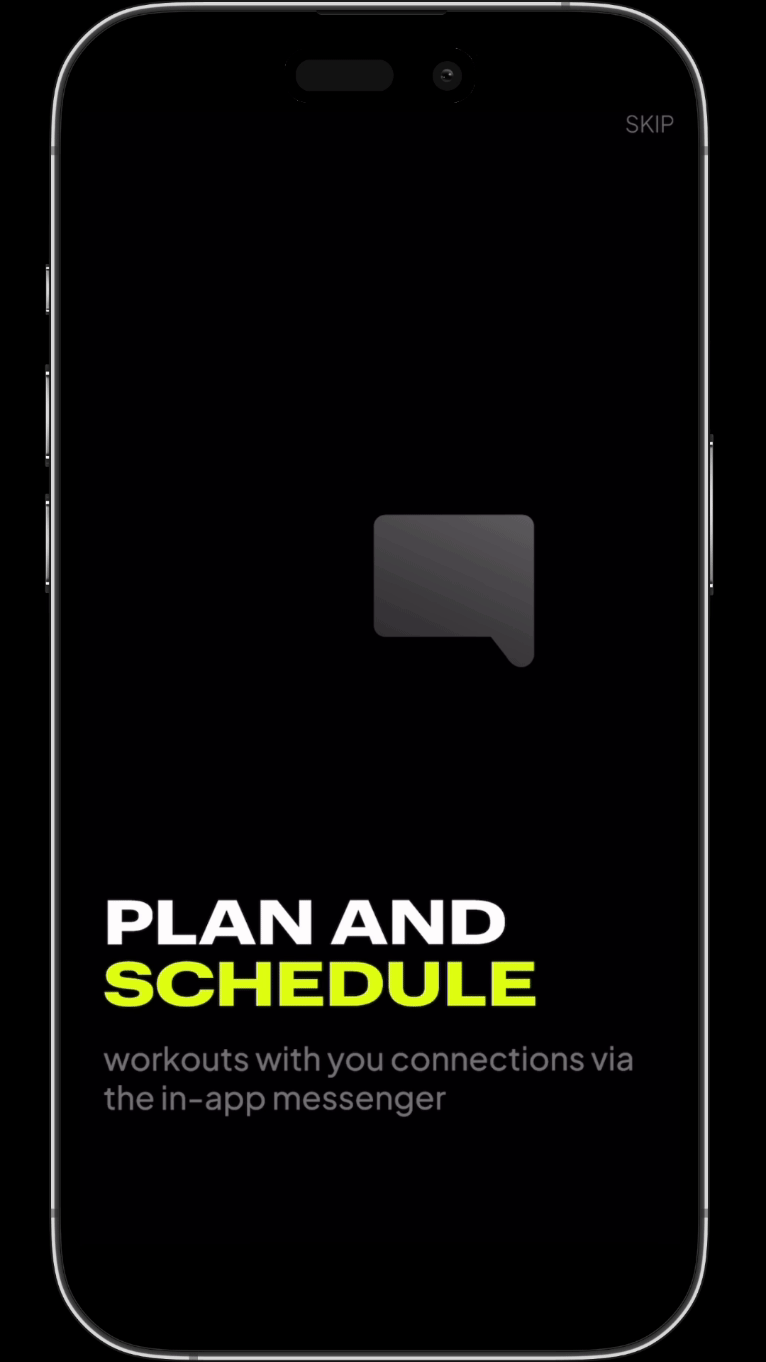
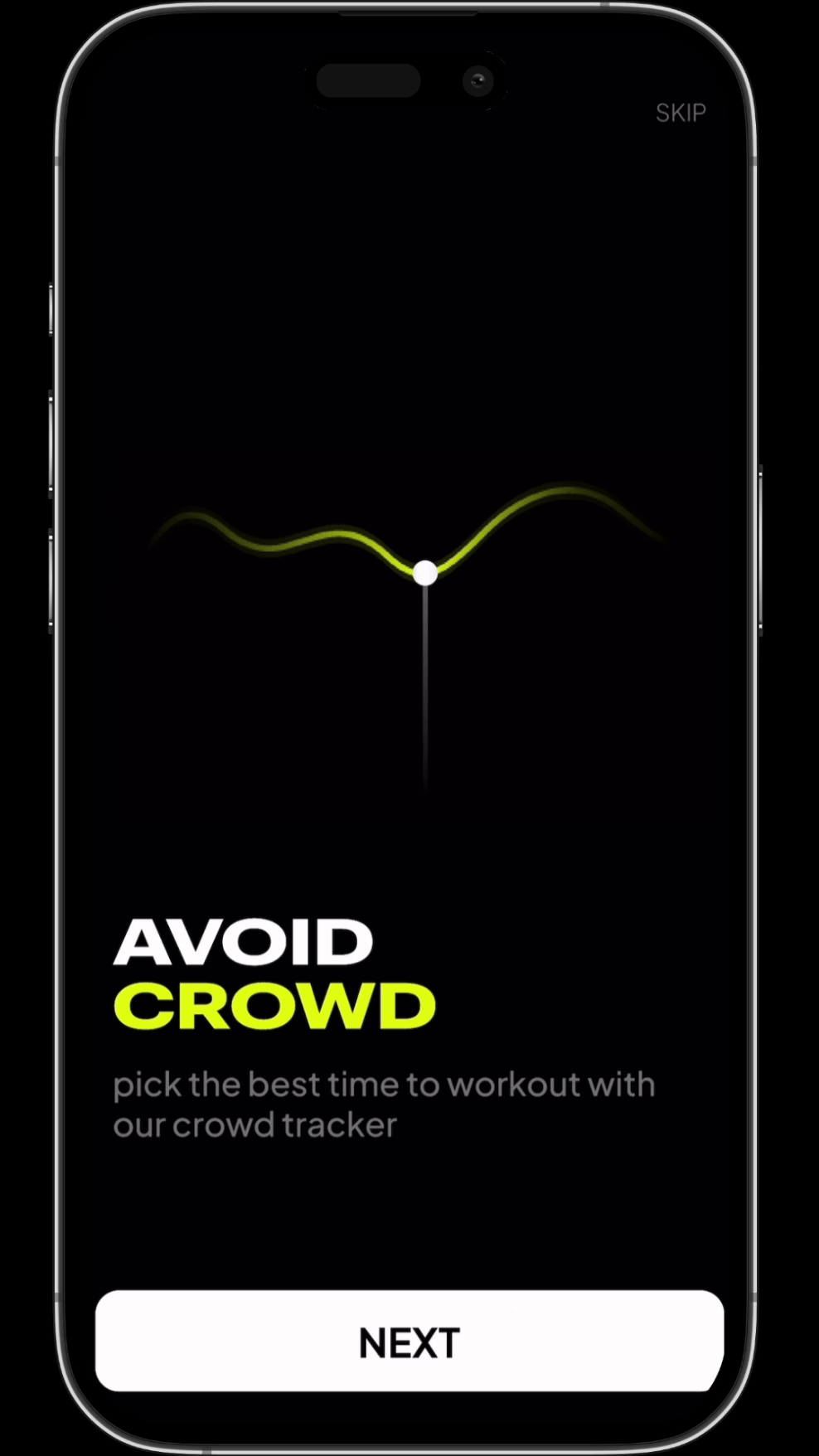
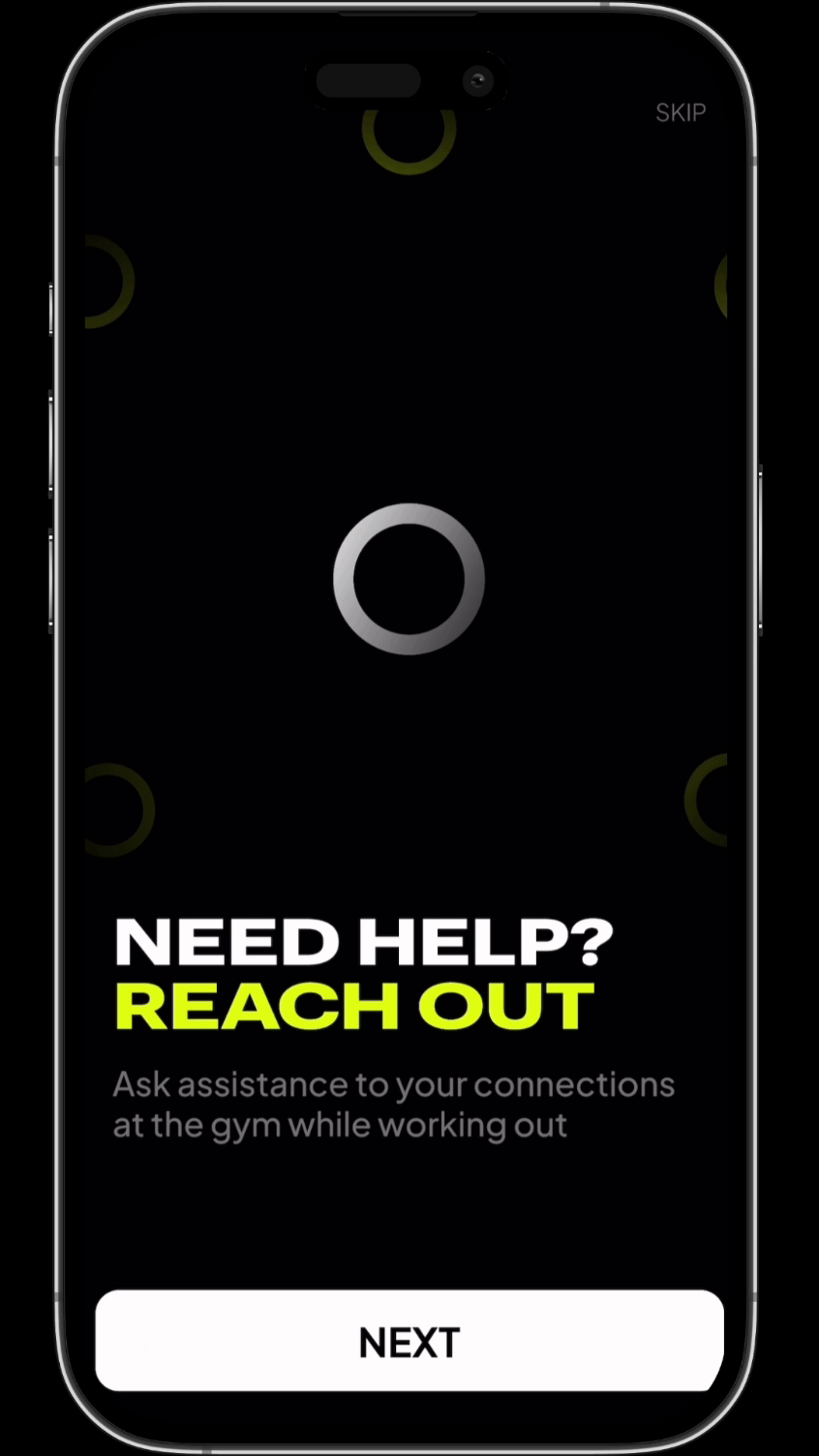

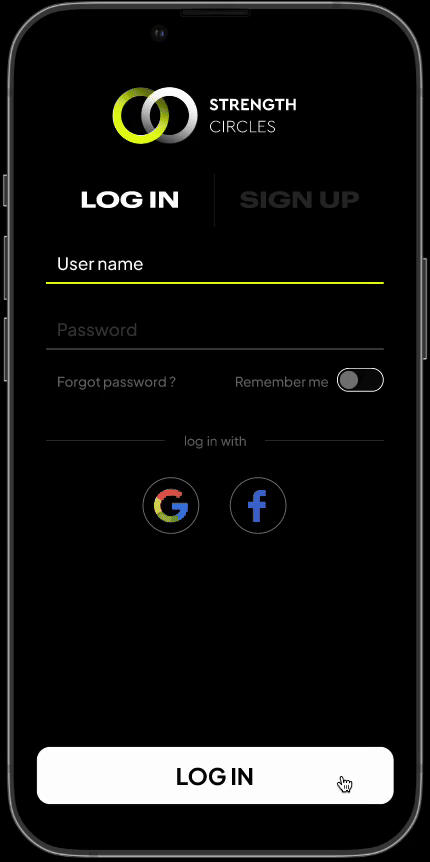
Create profile
Users can easily create profile cards for others to swipe on simultaneously while creating their account.
They can upload a display picture, select pronouns, and learn about profile metrics. They can choose fitness activities, write a brief bio, and upload training photos, videos, and music preferences.
This approach showcases their gym vibe, enhances engagement, and boosts credibility. Usability testing showed high participant approval.


Pick gym
The design was iterated to allow users to select their gym during profile creation, limiting visible profiles to fellow gym members. This approach encourages gyms to promote app use among clients.
Additionally, the revised design displays all nearby users, with map clusters highlighting gyms based on user density and activity levels, showcasing active communities. Users can choose to view all nearby users or focus on a specific gym, enhancing connectivity and interaction.
Interstitial ads.
Targeted advertisements related to fitness are placed between profile swipes, generating revenue for the App.



Workout
Users can view the muscle group suggested for training by the app.
Additionally, the app displays all the connections working out that day, highlighting those focusing on the same muscle group.
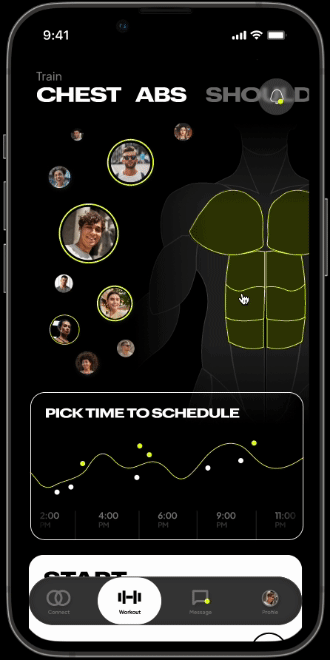
Pick Time
The app displays a graph of projected gym crowd levels throughout the day, with markers showing connections.
Users can select a time to schedule their workout or see who is working out then.
The information-rich yet minimal visual was refined through multiple iterations and A/B testing, and it succeeded in usability tests.
Send workout request
Users can reach out via a message or send a workout request by tapping on the display picture of a connection.
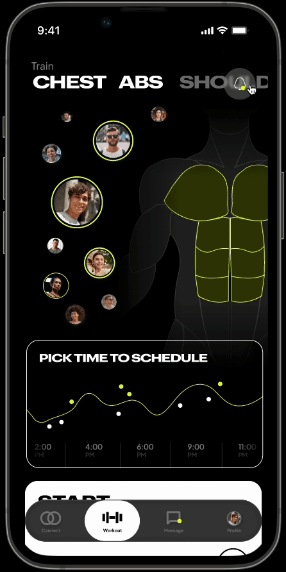
Change muscle group
Users can adjust their focus muscle group for the day by tapping on an interactive graphic or selecting the muscle name from a slider.
This feature lets them see which connection is working on what muscle and join them accordingly.

Schedule workout
Users can easily pre-plan their workout by picking variations from a recommended list.

Workout suggester
The App provides recommended workout splits tailored to users based on their preferences, experience levels, and workout history.
This is a premium feature.
Swipe, match and connect
Users can swipe right or left on the profile cards of fellow gym members to connect.
A successful match is notified with an animation.
They can also filter profiles based on gender and interests in various fitness activities.


In-app Messenger
Users can message their connections through the primary navigation.
They can also favorite connections to pin them at the top of the screen for easy access.
Plan together
Matched users can plan workouts collaboratively within the chat.
Their choices are updated in real-time on both devices for seamless coordination.

Watch and learn workouts.
Users can view short stock videos demonstrating execution of each exercise
Ask for assistance.
Users can request help from other app users at the location for any exercise, whether they need a spotter, instructions, or form validation.

Log workout.
Users can log sets of variations.
Push Notifications.
Timely push notifications for essential app features are designed to intrigue users and encourage consistent workout engagement.
Notifications can be viewed through a floating icon, which opens an overlay displaying notifications as tiles with necessary buttons.

Premium Subscription.
Pop-ups inviting users to upgrade to the premium version appear at intervals or when accessing premium features, highlighting the benefits.
The call-to-action includes clear subscription cost details per month and a description of the billing cycle for user clarity.




View Profile.
Users can view their profile as others do, with an added button to edit it. Additionally, they have access to a list of their connections.
Upload Media.
Users can upload videos or pictures to their profile as a visual introduction and a training journal.
Settings.
Users can adjust their preferences, edit details, or delete their profile through the settings menu.
Product Design Process
Kano cards
The potential app features that could be beneficial for the target users are listed as numbered cards with titles and explanations. They are tagged as basic, performance-based, or delighters, providing a structured overview of their significance.
MoSCoW Prioritization
I distinguished essential functionalities crucial for the app's core operation from less critical, exciting features. This prioritization ensured we focused on building a perfect cupcake rather than an incomplete wedding cake.




Wireframing
Hand-drawn wireframes were drafted to visualize the app's key features
Iterations





Style
Color
# E0FE10
# 7C7C7C
# 3B3B3B
Type
Plus Jakarta Sans
Light, Regular, Medium, Semibold, Bold.
Graphik Wide
Semibold, Bold.
Logo
Main logo


Primary Navigation

Usability test
I created a User Testing Template in Miro to collect and analyze participant activity and insights.
The results were analysed to find user pain points.
The design was iterated by implementing the changes necessary for optimised experience.






Changes Implemented




Viability test
Risky assumption
The app can achieve quick, widespread adoption among gym-goers.
Experiment
I advertised the app via social media and posters at Thomas Jefferson University.
Download links directed users to a mock official website where they could sign up if they found the app useful.



Result



Risky assumption
Users would match and connect with other members at their gym in the app.
Experiment
I created Profile Cards using information from the Heyflow form and exchanged them among participants.
The Profile Cards were sent to the contacts they provided, including phone numbers and GroupMe profiles. They expressed interest by liking or replying "Yes."


Result

Risky assumption
Users would want to schedule workouts with their connections.
Experiment
I matched participants with mutual interests and grouped them on iMessage, encouraging them to schedule workouts and share post-workout selfies. I also reminded participants of their upcoming workouts.



Result

Success Metrics






Key Takeaways
Comparing user acquisition rates from viability tests, it was clear Strength Circles needed gym partnerships to thrive initially.
The app helps beginners who feel alienated at the gym by enabling easier online connections, making them feel welcomed and comfortable around familiar faces even without working out together.
The app helps beginners who feel alienated at the gym by enabling easier online connections, making them feel welcomed and comfortable around familiar faces even without working out together.
What else
can it be?
What else
can it be?

Integrated into an existing gym's app.

Extension of an existing dating app

Serve as the foundation for a gym
bottom of page



